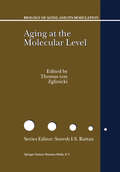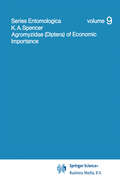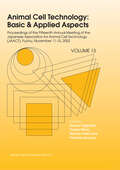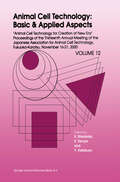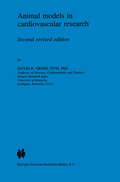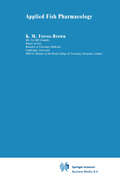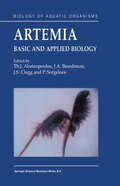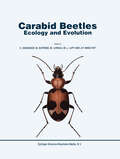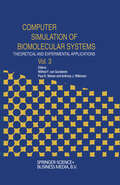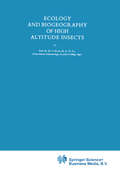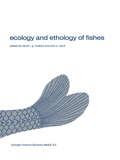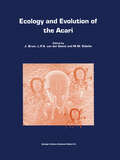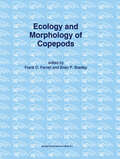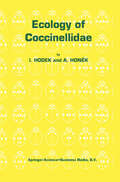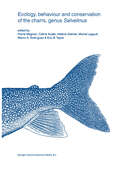- Table View
- List View
Aging at the Molecular Level (Biology of Aging and its Modulation #1)
by Thomas Von ZglinickiDuring the last 40 years, the study of the biological basis of aging has progressed tremendously, and it has now become an independent and respectable field of study and research. The essential cause of aging is molecular damage that slowly overwhelms cellular and organismic defense, repair and maintenance systems. In recent years, a wealth of highly sophisticated research has transformed this idea from a credible hypothesis not only to a major theory, but essentially to accepted knowledge. Aging at the Molecular Level examines the key elements in this transformation. Bringing together contributions from an international team of authors, this volume will be of interest to graduates and postgraduates in the fields of medicine and nursing, researchers of different aspects of biogerontology and those in the pharmaceutical, cosmeceutical, nutraceutical and health-care industry.
Aging of Cells in and Outside the Body (Biology of Aging and its Modulation #2)
by S. Kaul Renu WadwhaThis book provides updated knowledge on the basic features and mechanisms of cellular aging established since its first manifestation at cellular level 40 years ago. Contributions of genetic and environmental factors, failure of genetic and cellular repair mechanisms, and the epigenetic modifications determine the final lifespan of cells. This book also provides an understanding on how aging mechanisms in mice, a most frequently used model, differ with that of humans who receive better tumor surveillance because of stringent controls on aging mechanisms. It also appraises the use of modern technology for aging studies and its intervention. This book serves as an excellent reading on cellular aging for undergraduate students, researchers and experts of this area.
Aging of Organisms (Biology of Aging and its Modulation #4)
by H. D. OsiewaczBiological aging as the time-depending general decline of biological systems associated with a progressively increasing mortality risk is a general phenomenom of great significance. The underlying processes are very complex and depending on genetic and environment factors. These factors encode or affect a network of interconnected cellular pathways. In no system this network has been deciphered in greater detail. However, the strategy of studying various biological systems has let to the identification of pathways and specific modules and makes it obvious that aging is the result of different overlapping mechanisms and pathways. Some of these appear to be conserved ("public") among species, others are specific or "private" and only of significance in one or a few organisms. This volume in the series on "Biology of aging and its modulation" specifically focuses on organismic aging. The book covers research on organisms from lower to higher complexity representing examples from very diverse taxa like photosynthetic plants, fungi, sponges, nematodes, flies, birds and mammals. Such a broad treatise of this complex topic provides a comprehensive "flavor" about the current issues dealt with in this rapidly growing scientific discipline.
Aging of the Organs and Systems (Biology of Aging and its Modulation #3)
by Richard AspinallDuring the last 40 years, the study of the biological basis of aging has progressed tremendously, and it has now become an independent and respectable field of study and research. This volume on "Aging of Organs and Systems", is an attempt to bring understanding to both the aging process and the disease processes of old age. Bringing together contributions from an international team of authors, it will be of interest to graduates and postgraduates in the fields of medicine and nursing, researchers of different aspects of biogerontology and those in the pharmaceutical, cosmeceutical, nutriceutical and health-care industry.
Agromyzidae (Series Entomologica #9)
by K.A. SpencerThe original stimulus which started KENNETH SPENCER on a study of the Agro myzid flies was an invitation, which he accepted, to translate from the German the monograph on Leaf Miners by Professor E. M. HERING. From this developed nearly 20 years of collaboration until Professor HERING's death in 1967. Dr. SPENCER has himself described over 600 new species in the family, many of which he collected and reared from known host plants during his extensive travels to all the five main continents. Largely as a result of his work, the number of species known in Britain has increased from 90 in 1945 to 313 today. He is thus uniquely qualified to write this book about the hundred and fifty or so species which are regularly associated with cultivated plants. Much of the taxonomic detail provided here will be of value primarily to specialists; but with the help of a microscope and the botanical host list (Chapter 2) and the numerous illustrations (mostly prepared by ANN SPENCER) those in agri cultural institutes and elsewhere should now be able to identify the majority of species found attacking crops in any part of the world.
Animal Cell Technology: Proceedings of the Fifteenth Annual Meeting of the Japanese Association for Animal Cell Technology (JAACT), Fuchu, Japan, November 11-15, 2002 (Animal Cell Technology: Basic & Applied Aspects #13)
by Kazumi Yagasaki Yutaka Miura Makoto Hatori Yoshihiro NomuraAnimal cell technology is a growing discipline of cell biology which aims not only to understand structures, functions and behaviors of differentiated animal cells, but also to ascertain their abilities to be used in industrial and medical purposes. The goal of animal cell technology includes accomplishments of clonal expansion of differentiated cells with useful ability, optimization of their culture conditions, modulation of their ability for production of medically and pharmaceutically important proteins and the application of animal cells to gene therapy, artificial organs and functional foods. This volume gives the readers a complete review of present state-of-the-art in Japan and other countries where this field is well advanced. The Proceedings will be useful for the cell biologists, biochemists, molecular biologists, immunologists, biochemical engineers and other disciplines related to animal cell culture, working in either academic environments or in industries of biotechnology and pharmacy.
Animal Cell Technology: Proceedings of the Thirteenth Annual Meeting of the Japanese Association for Animal Cell Technology (JAACT), Fukuoka-Karatsu, November 16–21, 2000 (Animal Cell Technology: Basic & Applied Aspects #12)
by Sanetaka Shirahata Kiichiro Teruya Yoshinori KatakuraAnimal cell technology is a growing discipline of cell biology, which aims not only to understand structures, functions, and behaviours of differentiated animal cells but also to ascertain their ability to be used for industrial and medical purposes. The goal of animal cell technology includes accomplishments of clonal expansion of differentiated cells with useful ability, optimisation of their culture conditions, modulation of their ability for production of medically and pharmaceutically important proteins, and the application of animal cells to gene therapy, artificial organs, and functional foods. This volume gives the reader a complete review of the present state of the art in Japan and other countries where this field is well advanced. The Proceedings will be useful for cell biologists, biochemists, molecular biologists, immunologists, biochemical engineers, and other disciplines related to animal cell culture, working in either academic environments or in industries of biotechnology and pharmacy.
Animal models in cardiovascular research (Developments in Cardiovascular Medicine #153)
by D.R. GrossInterest in the humane and scientifically justifiable use of research animals has intensified since the publication of the first edition of this textbook. This completely revised and updated text provides information essential to any researcher interested in using animal models for cardiovascular research, or any research which requires normal cardiovascular function. The format and presentation have been changed to make the text more easy to read and use. An introductory chapter offers general principles of animal selection, pre and post-operative care, preanesthesia, chemical restraint, analgesia, and the recognition of pain. The number of references cited has been almost doubled over the previous text and the chapter tabulating normal cardiovascular parameters from intact, awake animals, of those species commonly used in research, has been greatly expanded. Other chapters providing comprehensive data on the cardiovascular effects of opioids, tranquilizers, anesthetic agents and other drugs commonly used in cardiovascular research have been expanded with special emphasis on species variability to drug effects. The chapters on both naturally occurring and iatrogenic models of cardiovascular disease have also been expanded and updated.
Applied Fish Pharmacology (Aquaculture Series #3)
by K.M. Treves-BrownAs aquaculture continues to expand there is a need for greater knowledge of medicinal treatments both for the prevention and treatment of disease and for the economic husbandry of fish. This book, the first of its kind, is written for a worldwide readership. It is a reference manual for anyone involved in the selection of medicines for administration to fish. It will also be useful to administrators concerned with the legal control of aquaculture. The first part covers issues which affect all medicine's methods of administering drugs to fish, the various aspects of safety and the relevant legislation in countries with important aquacultural industries. Subsequent parts review the range of available medicinal substances and present current knowledge of the pharmacology and methods of use for each. Particular attention is given to safety issues - for the fish, for the person administering the medicine, for the consumer of medicated fish and for the environment.
Aquatic Telemetry: Proceedings of the Fourth Conference on Fish Telemetry in Europe (Developments in Hydrobiology #165)
by Eva B. Thorstad, Ian A. Fleming and Tor Fredrik NæsjeThis volume provides a selection of the most significant papers presented at the Fourth Conference on Fish Telemetry in Europe, in Trondheim, Norway, in 2001. Papers are focused on migratory patterns and habitat utilisation, social behaviour, physiological ecology, fisheries management, effects of human impact on fish populations, aquaculture and methodology, and new technology. This book is aimed at scientists and engineers actively involved in aquatic telemetry projects, aquatic biologists (marine and freshwater), fisheries biologists and managers.
Artemia: Basic and Applied Biology (Biology of Aquatic Organisms #1)
by Th. J. Abatzopoulos J. A. Beardmore J. S. Clegg P. SorgeloosThe objectives of this volume are to present an up-to-date (literature survey up to 2001) account of the biology of Artemia focusing particularly upon the major advances in knowledge and understanding achieved in the last fifteen or so years and emphasising the operational and functional linkage between the biological phenomena described and the ability of this unusual animal to thrive in extreme environments. Artemia is a genus of anostracan crustaceans, popularly known as brine shrimps. These animals are inhabitants of saline environments which are too extreme for the many species which readily predate them if opportunity offers. They are, thus, effectively inhabitants of extreme (hypersaline) habitats, but at the same time are able to tolerate physiologically large changes in salinity, ionic composition, temperature and oxygen tension. Brine shrimp are gener ally thought of as tropical and subtropical, but are also found in regions where temperatures are very low for substantial periods such as Tibet, Siberia and the Atacama desert. They have, thus, great powers of adaptation and are of interest for this capacity alone. The earliest scientific reference to brine shrimp is in 1756, when Schlosser reported their existence in the saltpans of Lymington, England. These saltpans no longer exist and brine shrimp are not found in Britain today. Later, Linnaeus named the brine shrimp Cancer salinus and later still, Leach used the name Artemia salina. The strong effect which the salinity of the medium exerts on the morphological development of Artemia is now widely recognised.
Beef Production from Different Dairy Breeds and Dairy Beef Crosses (Current Topics in Veterinary Medicine #21)
by G.J. More O'FerrallThis publication contains the proceedings of a Seminar "Beef production from different dairy breeds and dairy beef crosses", held in Ireland on April 13-15, 1981, under the auspices of the Commission of the European Communities (CEC) as part of the European Communities (EC) programme for beef production research. The CEC wishes to thank those representatives of Ireland who took responsibility for the organisation and conduct of this Seminar, notably Professor E.P. Cunningham, Dr. G.J. More O'Ferrall (local organiser), Dr. Patricia McGlaughlin and In particular, thanks are due to Dr. McGlaughlin Mr. R. Barlow. and Mr. Barlow for their recording of the discussions. Professor Ian Gordon of the Faculty of Agriculture, kindly made available the facilities of Lyons House, University College, for the Seminar. Thanks are also accorded to the Chairmen of the Sessions Professor D. Smidt, Dr. R.B. Thiessen, Professor A. Neimann Sorensen, Professor E.P. Cunningham, and to all the participants who presented papers and took part in the discussions. X OBJECTIVES The aims of the Seminar were to review recent comparisons of Holstein and Friesian strains with other dairy breeds for beef and veal production; to look at the use of beef breeds for crossing on dairy herds in various EEC countries, and to examine the economic and genetic balance between milk and beef traits in dual purpose bull testing and selection.
Carabid Beetles: Ecology and Evolution (Series Entomologica #51)
by J-P. Maelfait K. Desender M. Dufrêne M. Loreau M. L. LuffCell Culture Methods for In Vitro Toxicology
by Glyn N. Stacey Alan Doyle Margherita FerroCell Culture Methods for in vitro Toxicology introduces the reader to a range of techniques involved in the use of in vitro cell culture in toxicological studies. It deals with major cell types studied in the field of toxicology and will be useful for anyone wishing to start work with animal cell cultures or to refresh their knowledge relating to in vitro cell models. Fundamental chapters deal with the general biology of cytotoxicity and cell immortalisation these are key issues for in vitro systems addressing the `3Rs' principle. Up-to-date overviews deal with the use of cells from liver, brain and intestine. In addition, biochemical analysis of cell responses, biotransformation pathways in cells and recombinant approaches to the early detection of cell stress are also covered in detail. Prominent features of in vitro technologies also include regulation, biosafety and standardisation. Dedicated chapters deal with these issues in a practical way in order to lead the reader to the right source of information. This book provides an up-to-date, informative and practical review of cell culture methods for in vitro toxicology. It will be of equal benefit to students and experienced toxicologists with little experience of in vitro cell culture.
Cell Signalling in Prokaryotes and Lower Metazoa
by I. FairweatherCell signalling lies at the heart of many biological processes and currently is the focus of intense research interest. In multicellular organisms, it is central to how different types of cell communicate with each other and how they detect and respond to extracellular signals. Intercellular communication is vital to single-celled organisms as well, allowing them to respond to environmental cues and signals. To date, much of the understanding of signalling mechanisms has come from research on specific cell types (eg mouse lymphocyte and cardiomyocyte) or on organisms in which communication systems such as nervous and endocrine systems are well established. This volume therefore aims to 'fill the gap' by concentrating on 'simple organisms' where the elements of those signalling systems first evolved. Many of the groups covered contain important pathogens or parasites, and the potential for manipulating signalling pathways for therapeutic intervention will be highlighted.
Computer Simulation of Biomolecular Systems: Theoretical and Experimental Applications (Computer Simulations of Biomolecular Systems #3)
by W. F. Van Gunsteren P. K. Weiner A. J. WilkinsonThe third volume in the series on Computer Simulation of Biomolecular Systems continues with the format introduced in the first volume [1] and elaborated in the second volume [2]. The primary emphasis is on the methodological aspects of simulations, although there are some chapters that present the results obtained for specific systems of biological interest. The focus of this volume has changed somewhat since there are several chapters devoted to structure-based ligand design, which had only a single chapter in the second volume. It seems useful to set the stage for this volume by quoting from my preface to Volume 2 [2]. "The long-range 'goal of molecular approaches to biology is to describe living systems in terms of chemistry and physics. Over the last fifty years great progress has been made in applying the equations representing the underlying physical laws to chemical problems involv ing the structures and reactions of small molecules. Corresponding studies of mesoscopic systems have been undertaken much more recently. Molecular dynamics simulations, which are the primary focus of this volume, represent the most important theoretical approach to macromolecules of biological interest." ...
Contemporary Studies on Fish Feeding (Developments in Environmental Biology of Fishes #7)
by Charles A. Simenstad Gregor M. CaillietGUTSHOP '84 was the fourth in a series of workshops on various aspects of fish feeding (Table 1). Initially, the organizers merely invited regional (Pacific Northwest) fisheries scientists to share, and possibly develop mutual solutions to, the many technical problems associated with trying to obtain meaningful, quantitative information from fish stomach contents, and the subsequent statistical treatment and interpretation of the multivariate data. Since then, although not explicitly based upon any internal cycle, these scientists and increasingly more and more dispersed colleagues continued to congregate for workshop deliberations every two or three years. From the 49 attendees at the first workshop, the number of participants had grown to 65 at GUTSHOP '78, and 107 at GUTSHOP '81. By the third workshop, we were drawing scientists from across the U. S. and Canada, and from as far away as Norway. The topical content of the workshops has also evolved from the predominantly technical aspects of fish collection and stomach contents processing techniques, statistical analysis, and data manipulation and presentation to considerations of theoretical ecology, bioenergetics, and behavior.
Diagnostic Ultrasound and Animal Reproduction (Current Topics in Veterinary Medicine #51)
by A. H. Willemse M. A. M.TaverneThe use of ultrasonic imaging techniques for diagnostic purposes in veteri nary medicine and animal science has lagged far behind their use in human medicine. In the area of domestic animal reproduction, diagnostic ultrasono graphy has a relatively short history. Reports on B-mode scanning first appeared as late as 1969, when Stouffer and co-workers used it for counting foetal numbers in late gestation sheep. After Lindahl had re-evaluated the potential of two-dimensional ultrasonography for pregnancy diagnosis in sheep in 1976, results of the first large scale field-trials by Fowler and Wilkins on predicting foetal numbers during the first half of gestation in sheep were published as recently as 1980. In this year also the first paper, by Palmer and co-workers, on ultrasonic scanning of the uterus and ovaries in the mare appeared. The improvement of diagnostics which was achieved by the application of this technique is illustrated by its present routine use in clinical equine practice and sheep breeding. Besides offe ring an accurate early pregnancy diagnosis in species such as the horse, cow, sheep, goat, pig and dog, ultrasonography enables the visualization of ovarian and uterine structures for the identification of both physiological and pathological conditions. In this way it replaces or supplements the more common diagnostic techniques used by the general practitioner so far. Ultrasonography has also opened several new lines of research for clini cians and research workers.
DNA Methods in Clinical Microbiology
by P. SingletonDNA Methods in Clinical Microbiology describes the novel DNA-based technology now used in the diagnosis and management of infectious diseases. It is a concise, yet readable, overview written primarily for clinicians, clinical microbiologists, medical students and undergraduates in medical and veterinary microbiology. The book has two primary aims. First, to explain the principles of these methods at the `molecular' level. Second, to provide a clinical perspective by reporting results from actual DNA-based investigations on a range of specimens. Those approaching DNA methods for the first time are assisted by a brief résumé of the relevant features of nucleic acids (Chapter 2): this information is essential for an understanding of later chapters. Subsequent text covers detection, characterization and quantification of pathogens by a variety of methods - e.g., target amplification (PCR, LCR, NASBA, TMA and SDA), signal amplification (bDNA) and probe-based techniques; the chapter on typing describes nearly twenty named molecular methods, including spoligotyping and MLST. All chapters include an adequate range of current reference from which, if required, detailed protocols can be obtained. The diagrams are clear, and readers are assisted by a detailed index.
Ecology and Biogeography of High Altitude Insects (Series Entomologica #4)
by M.S. ManiIn my book Introduction to High Altitude Entomology, published in 1962, I summa rized the results of eight years' studies, mainly on the Himalaya. I have since then had the opportunity of studying the collections of high altitude insects from the Alps, Carpathians, Caucasus, Urals, Alai-Pamirs, Tien Shan, Altai and other im portant mountains of the world in different museums and institutions in Europe. Through the courtesy and generosity of the Academy of Sciences of the Union of Soviet Socialist Republics, I was also able to personally collect insects and make valuable field observations on the Caucasus, the Alai-Pamirs, Ala-Tau and the Tien Shan mountains. Through comparative studies I have tried to synthesize the fundamental principles of high altitude entomology. I have described here the distinctive characters of the high altitude environment, the ecological specializations of the high altitude insects, their ecological inter relations and the outstanding peculiarities of their biogeography. I have also pre sented here an outline of the high altitude entomology of the principal mountains of the world, with brief accounts of their orogeny, geology and vegetation. This book differs from all other contributions in the field in its comparative ecological approach and in the fact that the main emphasis is throughout on the evolution of the high altitude ecosystem as an integral part of the orogeny. High mountains are, in all parts of the world, important and independent centres of origin and differ entiation of distinctive and highly specialized ecosystems and faunas.
Ecology and ethology of fishes: Proceedings of the 2nd biennial symposium on the ethology and behavioral ecology of fishes, held at Normal, Ill., U.S.A., October 19–22, 1979 (Developments in Environmental Biology of Fishes #1)
by David L. G. Noakes J. A. WardProceedings of the 2nd Biennial Symposium on the Ethology and Behavioral Ecology of Fishes, held at Normal, Ill., U.S.A., October 19-22, 1979
Ecology and Evolution of the Acari: Proceedings of the 3rd Symposium of the European Association of Acarologists 1–5 July 1996, Amsterdam, The Netherlands (Series Entomologica #55)
by J. Bruin Leo P. S. Van Der Geest M. W. SabelisAcarology is on the move! The growing interest from evolutionary and molecular biologists and from population and community ecologists in mites and ticks has a strong impetus on the field of acarology. This book contains many chapters that illustrate the recent progress in the field.
Ecology and Morphology of Copepods: Proceedings of the 5th International Conference on Copepoda, Baltimore, USA, June 6–13, 1993 (Developments in Hydrobiology #102)
by Frank D. Ferrari Brian P. BradleyEcology and Morphology of Copepods is organized under the following general topics: Behavior, Feeding, Genetics, Horizontal Variations, Morphology, Phylogeny, Reproduction, Seasonal Changes, Vertical Distribution, plus two special sessions on copepods of the genus Acartia and cyclopid/mosquito interactions. The Maxilliped Lecture, given by Dr. Arthur G. Humes of Boston University, clearly established the importance of copepods to the earth's organic diversity. The book consists of selected research articles from the different sections. The articles published here reflect the diverse research interests of copepodologists today, and are distinguished by their high quality. Their impact will ensure that this volume is consulted by a wide range of research biologists.
Ecology of Coccinellidae (Series Entomologica #54)
by Ivo Hodek Alois HonekCoccinellids have been very actively studied in the course of the twenty three years since "Biology of Coccinellidae" was published. The great amount of new, and often very important findings have made the previous book outdated and a new synthesis is needed. No other monograph of similar focus and extent has appeared. Iablokoff Khnzorian's "Les Coccinelles" (1982), limited to the tribus Coccinellini, and Gor don's "The Coccinellidae of America North of Mexico" (1985) both concentrate on taxonomy. Majerus' beautiful "Ladybirds" (1994) deal specifically with British coc cinellids and address chiefly amateur naturalists. The focus and the title of the recent book are slightly different from the 1973 vol ume. If a satisfactory comprehensive review of important new findings is attempted, the book would grow too much, due also to References and Indexes. To keep the vol ume at a tolerable extent, the section on larval identification of Palaearctic species has been omitted; not much could be added to the previous version of that part, any way. However, we have kept Kovar's chapter on morphology and anatomy, because of its relation to feeding and other ecological aspects. The chapter on phylogeny was updated also by him. Our Polish friend, Piotr Ceryngier, who has recently specialised in parasites, updated perfectly the parts on parasites and pathogens in Chapter 8. We would be glad if their contribution is quoted by their names. It seems to us that the remarks, contained in the reprinted preface to the previous volume, remain pertinent today.
Ecology, behaviour and conservation of the charrs, genus Salvelinus (Developments in Environmental Biology of Fishes #22)
by Pierre Magnan Céline Audet Hélène Glémet Michel Legault Marco A. Rodríguez Eric B. TaylorSalvelinus species are one of the most thoroughly studied groups of fishes. Many reasons explain this intense interest in charr biology. Charrs have a Holarctic distribution encompassing many Asian, North American, and European countries and occupy diverse marine and freshwater environments. Furthermore, the current distribution of charr includes areas that were directly influenced by climate and topographic change associated with the many Pleistocene glaciations. Undoubtedly, these conditions have promoted much of the tremendous morphological, ecological, and genetic variability and plasticity within Salvelinus species and they make charr very good models to study evolutionary processes 'in action'. Many charr species also exhibit demographic characteristics such as slow growth, late maturity, and life in extreme environments, that may increase their susceptibility to extinction from habitat changes and overexploitation, especially in depauperate aquatic habitats. This vulnerability makes understanding their biology of great relevance to biodiversity and conservation. Finally, charr are of great cultural, commercial, and recreational significance to many communities, and their intimate linkage with human societies has stimulated much interest in this enigmatic genus. This volume comprises a selection of papers presented at the fourth International Charr Symposium held in Trois-Rivières (Québec, Canada), from 26 June to 1 July 2000. It includes 31 papers on ecological interactions and behaviour, trophic polymorphism, movement and migration, ecophysiology and evolutionary genetics, ecological parasitology, environmental stress and conservation. These studies cannot cover all recent developments in the ecology, behaviour and conservation of Salvelinus species, but collecting them into a special volume should bring attention to current research on this important genus and stimulate further work on Salvelinus species.
